Simple and trouble-free tomato “Khlynovsky”: characteristics and description of the variety
Khlynov is the old name of the modern city of Kirov, where the hybrid tomato variety Khlynovsky was bred in 1999. The variety has established itself as unpretentious with increased resistance to various diseases and an extraordinary ability to take root in any climatic conditions, from the warmest to the coldest.
In a word, the plant is strong and resilient. It is the ability to adapt to unfavorable factors that is reflected in the name of the variety, because the city of Khlynov is a place of exile for Russian rebels, and only the most persistent could survive in harsh conditions.
Characteristics and description of the variety
The culture was selected by scientists from the company "Agrosemtoms".
The bush is determinate, compact, but vigorous. Height 1.5-1.9 m. Leaves are dark green. The inflorescences are simple, formed after 2-3 leaves. The first inflorescence is laid above the 8-10th leaf, the formation is uniform, due to which all the fruits are the same size.
The brush sets up to 6 fruits. The stem is strong, despite its height. Unlike other tall hybrids, fruit ripening occurs two weeks earlier. From the moment the seeds are sown until full ripening, 105-110 days pass.
Recommended for breeding both in open ground and greenhouse conditions. The hybrid genes contain high resistance to diseases such as fusarium, cladosporiosis, verticillium and tobacco mosaic.
Adapted to temperature changes, withstands cold weather well.
Productivity is high: from 1 sq. m, up to 14 kg of vegetables are collected, provided that 3 bushes are placed per 1 sq. m. m. Fruiting is extended, until late autumn.
The plant requires staking and pinching. The bush is capable of limiting its growth by itself, having reached a certain height, so pinching the top is not required.
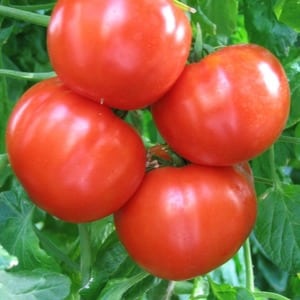
The fruits are not large, but heavy, weighing 250-300 g. The color is bright red. The peel is thin. The taste is excellent, sweet. Chambers 4-6 with a large number of seeds.
In the photo on the right is a tomato Khlynovsky f1.
Universal in use: from fresh consumption to whole-fruit canning and tomato products.
It can be stored for a long time and can withstand long-term transportation without loss of appearance and gastronomic properties.
How to grow seedlings
Sowing of seeds begins at the end of March or beginning of April, 50 days before planting the seedlings in the ground. Suitable soil for seedlings is garden soil mixed with sand and humus. You can plant both in a common box and in individual containers. The main thing is to thoroughly moisten the prepared soil before sowing the seeds.
The material is placed in grooves 1 cm deep. Greenhouse conditions are created for speedy germination. The seeded containers are covered with film or glass to maintain moisture until the first shoots appear. Then the containers are placed in a warm and well-lit place where the air temperature is not lower than 23°C.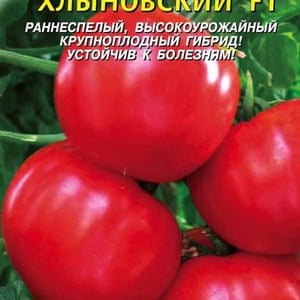
When the first shoots appear, glass or film is removed from the containers. The room temperature should still be at least 23°C. Otherwise, the sprouts will begin to stretch in length and the stem will become fragile. It is important not to allow moisture to stagnate, as overmoistening increases the risk of fungal diseases.
As soon as 2-3 true leaves appear, pick.If the seeds were sown in a common box, at the picking stage the sprouts are planted in a separate container. After picking, the seedlings grow faster, absorbing more moisture.
Two weeks later, the first fertilizing is carried out with potassium humate, which promotes better formation of the root system.
Reference. The variety is a hybrid, so it is impossible to independently select seeds for the next planting.
2 weeks before transplanting into open ground, seedlings begin to harden. On a daily basis, seedlings are taken out into the open air. The initial time for this procedure is 2-3 hours. Gradually, the duration of hardening increases to 1 day. It is important that the temperature at night, where the seedlings will remain until the morning, is not higher than 13°C.
Reference. If the seedlings are not transplanted to a permanent place for more than 50 days, flower buds will form on them, which must be removed.
How to grow tomatoes
After 50 days, when 5-7 true leaves appear on the young bushes, the seedlings are ready for transplanting. At this point, the sprouts need regular watering.
Planting pattern: 60 cm between seedlings and 45 cm between rows.
A handful of humus and 10 g of superphosphate or 1 tablespoon of wood ash are added to each hole. For better growth, seedlings are sprayed with stimulants, for example, “Extra” or “Novosil”. It is best to transplant seedlings on a cloudy day or in the evening.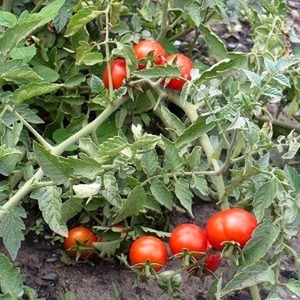
Water daily in the evening. Do this at the root, without touching the leaves. This method helps protect plants from late blight. The culture responds well to drip irrigation.
After the seedlings have taken root and started to grow, the number of waterings is reduced to 2 times a week. If it's too hot outside, water three times a week.
During fruit development, plants especially need a lot of water. During this period, they are watered every other day.
After watering, the soil is loosened, hilled up and weeds are removed. Hilling promotes oxygen access to the roots. To retain moisture in the soil, the beds are mulched. Mulching also protects against insect pests that move along the ground.
Feeding carried out every week during the ripening of the first fruit clusters. They are fed with mineral fertilizers, for example, a solution of ammonium nitrate, potassium sulfate, magnesium and potassium humate. The solution is made as follows: 20 g of saltpeter, 30 g of potassium sulfate, 10 g of magnesium and 25 ml of 3% potassium humate are dissolved in 10 liters of water. The same fertilizer is used during fruit filling.
Culture requires mandatory stepsoning. If a tomato grows in a greenhouse, the plant is formed into one stem; in open ground - in two stems. All lower leaves are removed for better air access.
Due to your height, you can't do without a garter. To do this, a wooden support or metal rods are installed next to each bush. Branches with tassels are also supported, otherwise they will break off under the weight of the fruit.
Reference. The hybrid grows well in open beds both in the Moscow region and in Siberia.
Diseases and pests
As mentioned earlier, the variety is highly resistant to typical diseases of the nightshade family. It is also resistant to attacks by parasitic insects.
But, as a rule, in each plot, in addition to tomatoes, other crops grow that can attract pests and infections. Preventative measures will keep plants healthy.
Watering and lighting regimes, timely loosened and fertilized soil saturate the plant with nutrients, which increases its immunity.
Copper sulfate is used as a preventive measure against late blight. Late blight is a fungal disease, so in some cases it is enough to monitor the level of soil moisture. In a greenhouse, ventilation is a good preventative measure, and in open ground, this function is performed by a light southern breeze.
As for insect pests, the use of insecticides on tomatoes is undesirable, but some traditional methods are worth paying attention to:
- Treatment with a soapy solution works well against aphids and spider mites.
- Regular inspection of the bushes prevents the appearance of slugs and the Colorado potato beetle on them.
- Planting fragrant herbs next to tomatoes repels mole crickets and some flying insects from the beds. Chopped cloves of garlic buried in the beds also help well in the fight against mole crickets.
The nuances of growing in open ground and in a greenhouse
Seedlings in a greenhouse gain greater height than in open beds. But pinching the top is not carried out, since upon reaching 1.9 m the plant tops itself, that is, it stops further growth. And all nutrients are directed to the formation and development of fruits, and not to the growth of branches.
In greenhouse conditions, fungus develops more often. To prevent high humidity from causing mold, the greenhouse must be regularly ventilated. In addition, a constant flow of fresh air prevents the proliferation of greenhouse spider mites.
In a greenhouse, the variety shows the greatest productivity when formed into 1 stem. Recommendations for cultivation in open ground indicate growing the plant with 2 stems. It is in this case that the crop will delight you with maximum offspring.
Harvesting and application
Harvesting begins in July and continues until late autumn. Extended fruiting suits many gardeners. The bushes are strewn with fresh vegetables for a long time.
Harvesting tomatoes from tall, tied plants is not difficult. They all grow the same size due to the uniform formation of inflorescences.
In regions where summers are short and cool, tomatoes are harvested unripe, as they are able to ripen on their own. Moreover, this will happen faster than in the garden beds.
At a temperature of +10°C, all vegetables can be harvested, even green ones. In the cold, tomatoes stop developing and may rot. And in the warmth, at home, they will ripen perfectly on their own.
Ripe vegetables are universal in use. Juices, lecho, ketchup, adjika are made from them, marinades, pickling. Tomatoes retain their flavor well when whole-fruit canned. And of course, they are great for fresh consumption: in summer salads, in vegetable dishes, for example, stews, purees.
Thanks to its long-term storage and ability to withstand long-term transportation, the variety is ideal for commercial cultivation. Despite transportation to any point, vegetables retain their marketable appearance by 98%.
Advantages and disadvantages
Now let's get acquainted with the positive and negative sides of the Khlynovsky f1 tomato. Perhaps its most significant advantage is its unique ability to adapt to various climatic conditions, even in unprotected soil.
Other positive characteristics: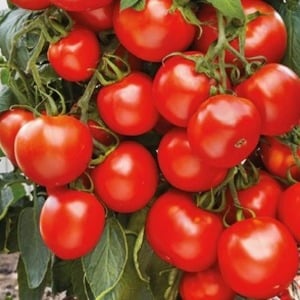
- ease of care;
- increased immunity to diseases;
- high quantitative indicator;
- early maturation;
- extended fruiting;
- excellent taste of fruits;
- vegetables of the same size;
- universal application;
- long-term storage;
- long transportation;
- excellent presentation.
Some disadvantages of this variety:
- dependence of plant development on proper watering;
- required garter;
- stepsoning required;
- impossibility of independent seed selection.
Farmer reviews
Reviews from those who planted the Khlynovsky tomato once again confirm the reliability of this crop. Many photographs indicate a presentable appearance. But they especially note the excellent taste of ripe tomatoes. There is an opinion that it is impossible to get enough of them; you want more and more.
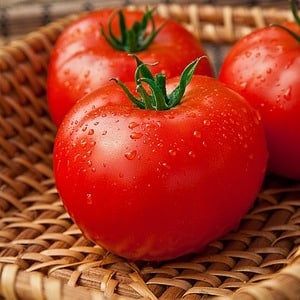
Tatiana, Moscow: “The summer weather has been very changeable lately. I don’t want these changes to affect the harvest. For the first time, I planted the Khlynovsky hybrid, which is resistant to temperature changes. Didn't disappoint. I’ll try to plant more.”
Gennady, Kirov: “I grew it for the second season and was again convinced of the merits of the variety. Tasty, productive, highly resistant to diseases. It is important to provide timely watering and fertilizing. But it's not difficult. I recommend it to everyone."
Alexander, Saratov region: “Khlynovsky was recommended to me by a friend. I liked the appearance of the tomato immediately. Tall, one brush forms many vegetables. And very simple care. But I don’t need more.”
Conclusion
There is no region where the Khlynovsky hybrid is not known. Juicy, fleshy fruits, the taste of which is liked by both adults and children, early ripening, high fruiting rate, easy care and resistance to diseases and unfavorable climatic conditions make the species more and more popular among gardeners.
The tomato, which has shown an unusually persistent character over its twenty-year existence, can rightfully be called a rebel among cultivated plants.